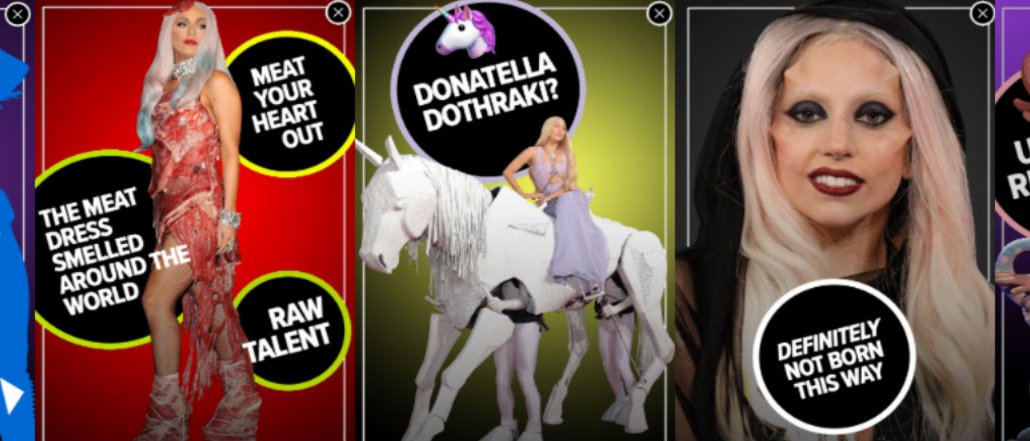Huffington Post copies Snapchat with new ‘storybook’ format

The Huffington Post is experimenting with its own version of Snapchat and Instagram Stories.
On Monday, February 6, inside of an article about Lady Gaga’s upcoming world tour, The Huffington Post debuted a new visual content format called “storybook,” which listed some of the musician’s more outrageous wardrobe choices. Made for HuffPost’s mobile site (but also available for desktop visitors), the format features ten vertical images and motion graphics that users can swipe or click through. As hinted at in the format’s name, it mimics the vertical content popularized by Snapchat and later Instagram.
“There were some things we were doing on Snapchat and Instagram — the storytelling mechanisms and animations that we can play with on those platforms — that we wanted to bring to readers on our owned and operated platform,” said Emily Ingram, senior product manager at The Huffington Post. “It’s eye-catching in a way that you might not otherwise find on our site.”
A team of seven staffers — Ingram, an editor, three developers and two designers — spent two weeks creating the storybook product, which is now available to everyone in HuffPost’s newsroom through the publisher’s in-house widget-builder platform. Once created, the platform provides an embed code to publish the storybooks inside articles, though HuffPost will also experiment with publishing the format as standalone pieces on its mobile sites and apps.
Initially, Ingram and her product team are working with HuffPost’s multimedia team, which includes social producers, illustrators and motion graphics experts, to create more storybooks. If the format performs well, the publisher expects to get more newsroom staffers involved.
“The best way to get things off the ground is to find a small group of collaborators who are willing to play ball and experiment, and then roll the product out more broadly based on what works,” Ingram said.
HuffPost is confident that storybooks will be a hit, citing the success the publisher had last year in launching a pop-up Snapchat Discover channel centering on sleep. In the 24 hours the Recharge channel was live, it attracted five times as many unique visitors as the average Snapchat Discover channel in April, according to HuffPost. On the first day of the Lady Gaga storybook, 90 percent of users that viewed the third card finished the entire storybook, HuffPost said.
This is not the first time The Huffington Post has experimented with new visual content formats, especially as visitors increasingly access the site on mobile devices. (Mobile by itself accounted for 70 percent of HuffPost’s U.S. traffic in December 2016, which totaled 76.6 million unique visitors, according to comScore.) Last year, HuffPost published two features on Donald Trump and domestic gun violence that presented information on cards that users could swipe or click through.
Other publishers have also adopted features initially popularized by Snapchat. The Washington Post, for instance, now makes vertical videos for its mobile sites and apps. Meanwhile, The Washington Post, Hearst and News Corp are all selling vertical video ads for their platforms.
“I’m a product manager. My job didn’t exist at a lot of news companies five years ago. And if it did, it was strictly a business role,” said Ingram. “But newsrooms are learning that they need to continue pushing themselves forward, to create new products and have the type of skillsets they need on staff to create those products.”
More in Media

Podcast companies turn to live events to capture growing advertiser spend
The surge in the number of live podcast events in 2025 reflects a broader shift: advertisers are betting bigger on podcasts — not just as an audio channel but as a full-fledged creator economy play.

Media Briefing: ‘Cloudflare is locking the door’: Publishers celebrate victory against AI bot crawlers
After years of miserably watching their content get ransacked for free by millions of unidentified AI bot crawlers, publishers were finally thrown a viable lifeline.

How Vogue could navigate potential industry headwinds as Anna Wintour — who agency execs say made ad dollars flow — brings on new edit lead
Anna Wintour’s successor at Vogue will have to overcome the myriad of challenges facing fashion media and the digital publishing ecosystem.








